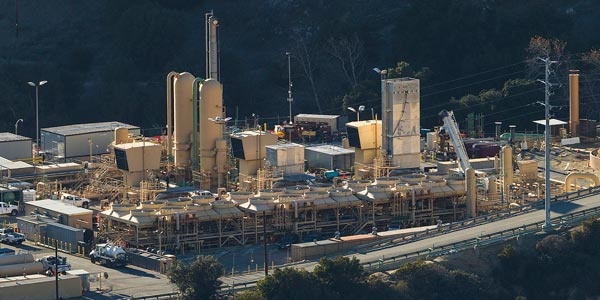By Robert Mullin
FERC on Tuesday approved CAISO’s request to extend temporary market measures instituted last year in response to natural gas pipeline restrictions stemming from the 2015 closure of the Aliso Canyon gas storage facility.
But the commission rejected the ISO’s proposal to make other gas-related measures permanent throughout the ISO and the Western Energy Imbalance Market (EIM), in addition to the Southern California region affected by the gas constraints (ER17-2568).
Aliso Canyon was cleared to resume normal operations in July, but is still operating at reduced capacity. CAISO sought to implement the permanent Tariff provisions to prepare for potential operational issues in other areas it oversees. (See Plan Would Apply Aliso Canyon Measures Across CAISO, EIM.)
In its ruling Tuesday, FERC accepted the ISO’s bid to extend a measure allowing Southern California generators to reflect gas cost expectations in day-ahead bids by using an approximation of next-day gas prices, which are published after the ISO’s day-ahead market runs. ISO rules typically require generators to incorporate the previous day’s gas prices into energy bids.
The commission also approved continued use of a gas adder and an after-the-fact cost recovery mechanism for generators connected to the Southern California Gas system to tie cost recovery and penalties to same-day gas prices rather than day-ahead gas indices.
“As CAISO reports, Aliso Canyon will continue to experience limited operability for the foreseeable future, which presents the risk of curtailments to gas-fired generators and, potentially, the interruption of service to load,” the commission said. “We find that continuation of the interim measures for an additional year should improve scheduling coordinators’ ability to manage their gas procurement and enhance their ability to recover gas procurement costs, while also providing CAISO with flexible tools to maintain reliability and avoid adverse market outcomes related to the limited operability of Aliso Canyon.”
The temporary provisions will remain in effect until Nov. 30, 2018.
Gas Burn Cap
FERC rejected CAISO’s proposals to make other interim measures permanent and to extend their application to the EIM. Chief among them was the ISO’s proposal to limit the amount of gas that generators can burn during periods of restricted gas supply.
Within its own balancing authority area, the provision would have allowed CAISO to develop the constraint on its own motion, then require it to publish details about the constraint and provide market participants an opportunity to comment.
In the EIM, the ISO would have enforced constraints “at the request of and in coordination” with the relevant EIM balancing authority. The EIM currently includes Arizona Public Service, NV Energy, PacifiCorp, Portland General Electric and Puget Sound Energy.
In rejecting the proposal, the commission found that CAISO failed to demonstrate how it would a prevent an EIM entity from having “too much discretion” over the development and enforcement of a constraint. “This raises the concern that an EIM entity would be able to develop a constraint to help it manage gas supply issues of its affiliated resources while other market participants would have to rely on appropriate bidding and contracting,” the commission wrote.
The commission also said that CAISO had not explained how it would monitor and enforce maximum burn constraints in the EIM, nor did it define the role of the relevant natural gas company within the Tariff.
Still, FERC left the door open for CAISO to develop a gas burn cap for its own BAA, saying such a measure could be a “useful tool” to help manage gas limitations “more efficiently than relying solely on manual dispatch.”
The commission also rejected CAISO’s proposals to make permanent two other interim measures: One allows the ISO to suspend virtual bidding in the face of gas constraints; the other permits it to release two-day-ahead advisory schedules to certain scheduling coordinators.
“These solutions may be appropriate for an interim Tariff provision to address an identified problem, such as Aliso Canyon’s limited availability, but CAISO has not provided justification that they are appropriate or adequate in their current form as permanent features of CAISO’s market,” the commission said.
FERC acknowledged that its denial of the permanent Tariff changes would leave CAISO without some existing tools designed to address limited operations at Aliso Canyon.
“Our rejection of these permanent Tariff provisions does not foreclose CAISO from proposing an extension of these interim Aliso Canyon-specific Tariff provisions for an additional year, as CAISO did with the three Tariff provisions that we accept on a temporary basis in this order,” the commission said.




